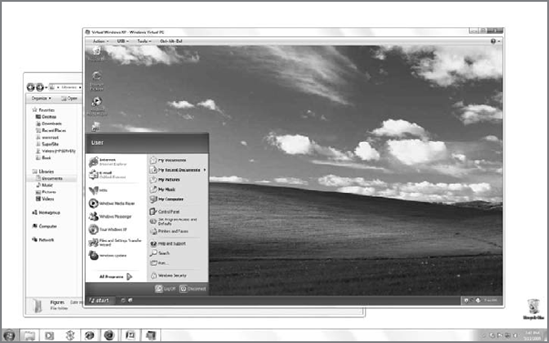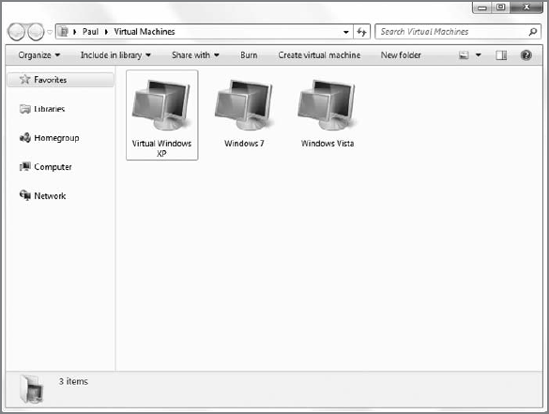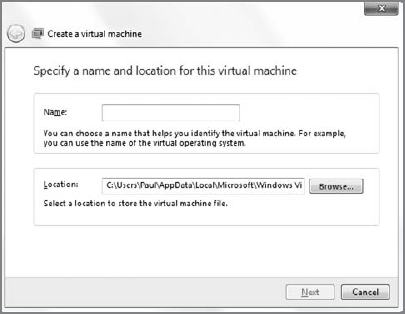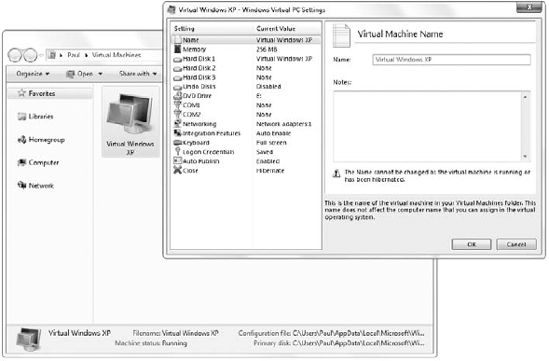2. Windows Virtual PC and XP Mode
When all else fails, a new Windows 7 feature can come to the rescue. Actually, there are two features involved:
Windows Virtual PC is a software solution that provides a virtual machine environment in which guest operating systems, with their own applications and services, can run separately and independently from the host environment, or physical PC. XP Mode
provides a virtual version of Windows XP in which you can configure
virtualized, XP-based applications to run side by side with native
Windows 7 applications. This effect is shown in Figure 11.

NOTE
Windows Virtual PC is free for all Windows 7
users, but Windows XP Mode is a perk of the Professional, Enterprise,
and Ultimate versions of the operating system. You can download both
from www.microsoft.com/windows/virtual-pc/download.aspx.
The next sections take a look at both of these new Windows 7 components.
|
Windows Virtual PC is the latest version of
Microsoft's venerable Virtual PC product line. Previously, this
environment was made available as a standalone application to users of
various Windows versions. With Windows Virtual PC, however, this
product is now a Windows 7 feature. And though it doesn't ship on the
disc with Windows 7, it can only be installed on Windows 7.
|
|
4.2.1. Understanding Windows Virtual PC
To the operating system and applications running in
a virtual environment like Windows Virtual PC, the virtual machine
appears to be a real PC, with its own hardware resources and
attributes. These virtualized systems have no knowledge or
understanding of the host machine at all.
Though virtual machines cannot rival the performance
of real PCs for interactive use—they're useless for graphically
challenging activities such as modern, action-oriented games, for
example—they are perfect for many uses. In fact, virtual machines are
often used to test software in different environments, or test Web
sites and Web applications with different browser versions.
NOTE
Looking for a way to play old DOS-based games
under Windows 7? Forget Windows Virtual PC. Instead, check out DOSBox.
It's awesome, and if you're looking for a Duke Nukem fix this is the
place to be (see www.dosbox.com).
In Windows 7, the Windows Virtual PC virtualized environment—shown in Figure 12—plays
a special role. Because new versions of Windows are often incompatible
with legacy applications, a virtual machine environment running an
older version of Windows and those incompatible legacy applications can
be quite valuable. Best of all, in such cases, users are often less apt
to notice any performance issue because older operating systems tend to
require fewer resources anyway.

That said, for the best results, anyone utilizing
Virtual PC to run an older operating system such as Windows XP along
with whatever set of Windows 7–incompatible applications is well served
to pack the host PC with as much RAM as physically possible. For
typical PCs today, that means loading up with 4GB. Remember: you're
running two operating systems and any number of applications
simultaneously. That old Pentium 3 with 256MB of RAM just isn't going
to cut it.
NOTE
Windows Virtual PC is available in separate 32-bit and 64-bit versions. Make sure you download the correct version for your PC.
NOTE
Windows Virtual PC has specific hardware
requirements, and thanks to the vagaries of microprocessor marketing,
your PC may not be up to snuff. The only important consideration,
indeed, is the microprocessor: in order to run Windows Virtual PC (and,
thus, XP Mode as well), you need a microprocessor that supports
hardware-assisted virtualization. And you must be able to enable this
functionality in the PC's BIOS. If you don't have such support, you'll
see the error message shown in Figure 13 when you try to install Windows Virtual PC.

This technology goes by different names depending on
which microprocessor vendor you're talking about. With Intel, it's
called Virtualization Technology (Intel VT). And with AMD it's simply
called AMD Virtualization (AMD-V). The vast majority of modern (for
example, 64-bit and multicore) AMD processors include AMD-V, so you're
generally in good shape if you're running a PC with an AMD processor.
But in the Intel world, you have some work ahead of you.
Let's get the simple part out of the way first. If
your PC utilizes an Intel i7 or i7 Extreme processor, you're all set.
All of these products include the necessary hardware support. For the
remainder of Intel's modern CPU lineup, however, you can refer to Tables 1 and 2.
Table 1. Intel Desktop Microprocessor Support for Hardware-Assisted Virtualization| Intel Microprocessor | Supports Hardware-Assisted Virtualization |
|---|
| Core 2 Duo E4300, 4400, 4500, 4600, and 4700 | No | | Core 2 Duo E6300, 6320, 6400, 6420, 6540, and 6550 | Yes | | Core 2 Duo E6600, 6700, 6750, and 6850 | Yes | | Core 2 Duo E7200, 7300, 7400, and 7500 | No | | Core 2 Duo E8190 | No | | Core 2 Quad Q6600 and 6700 | Yes | | Core 2 Quad Q8200, 8200S, 8300, 8400, and 8400S | No | | Core 2 Quad Q9300, 9400, and 9400S | Yes | | Core 2 Quad Q9450, 9550, 9550S, and 9650 | Yes | | Pentium D Pentium EE 805, 820, 830, and 840 | No | | Pentium D Pentium EE 915, 925, 935, and 945 | No | | Pentium D Pentium EE 920, 930, 940, 950, and 960 | Yes | | Pentium D Pentium EE 955 and 965 | Yes | | Pentium for Desktop E2140, 2160, 2180, 2200, and 2220 | No | | Pentium for Desktop E5200, 5300, and 5400 | No |
Table 2. Intel Mobile Microprocessor Support for Hardware-Assisted Virtualization| Intel Microprocessor | Supports Hardware-Assisted Virtualization |
|---|
| Core 2 Duo Mobile L7200, 7300, 7400, and 7500 | Yes | | Core 2 Duo Mobile P7350, and 7450 | No | | Core 2 Duo Mobile P7370 | Yes | | Core 2 Duo Mobile P8400, 8600, 8700, 9500, and 9600 | Yes | | Core 2 Duo Mobile SL9300, 9400, and 9600 | Yes | | Core 2 Duo Mobile SP9300, 9400, and 9600 | Yes | | Core 2 Duo Mobile SU9300, 9400, and 9600 | Yes | | Core 2 Duo Mobile T5200, 5250, 5270, 5300, 5450, and 5470 | No | | Core 2 Duo Mobile T5500, and 5600 | Yes | | Core 2 Duo Mobile T5550, 5670, 5750, 5800, 5850, 5870, and 5900 | No | | Core 2 Duo Mobile T6400, and 6570 | No | | Core 2 Duo Mobile T7100, 7200, 7250, 7300, and 7400 | Yes | | Core 2 Duo Mobile T7500, 7600, 7700, and 7800 | Yes | | Core 2 Duo Mobile T8100, and 8300 | Yes | | Core 2 Duo Mobile T9300, 9400, 9500, 9550, 9600, and 9800 | Yes | | Core 2 Duo Mobile U7500 and U7600 | Yes | | Core 2 Extreme Mobile QX9300 | Yes | | Core 2 Extreme Mobile X7800 and 7900 | Yes | | Core 2 Extreme Mobile X9000 and 9100 | Yes | | Core 2 Quad Mobile Q9000 | Yes | | Core 2 Quad Mobile Q9100 | No | | Core 2 Solo SU3300 and 3500 | Yes | | Core 2 Solo U2100 and 2200 | Yes | | Core Duo L2300, 2400, and 2500 | Yes | | Core Duo T2050 and 2250 | No | | Core Duo T2300, 2400, 2500, 2600, and 2700 | Yes | | Core Duo T2300E, 2350, and 2450 | No | | Core Duo U2400 and 2500 | Yes | | Core Solo T1300 and 1400 | Yes | | Core Solo T1350 | No | | Core Solo U1300, 1400, and 1500 | Yes |
If the PC you're using does not include a
microprocessor that supports hardware-assisted virtualization, you have
two options: you can use a different PC, of course. Or you could use a
competing virtualization solution that doesn't include such a
limitation. (Note, however, that no competing virtualization products
include a free copy of Windows XP.) We favor VMWare Workstation (www.vmware.com/products/ws) but if you would like a free solution, check out VirtualBox (www.virtualbox.org) instead.
NOTE
If your PC's processor has hardware-assisted
virtualization support but you failed to enable it in the BIOS, you
will see the dialog shown in Figure 14
when you attempt to install XP Mode or another OS in a virtual machine.
That means you have to reboot, enable the feature in the BIOS, boot
into Windows again, and then rerun Windows XP Mode Setup. So get this
set up first.

You manage Windows Virtual PC from a very simple
Virtual Machines explorer, rather than from the console application
window that accompanied previous versions. Shown in Figure 15, this window provides a toolbar button from which you can create a new virtual machine.
The Create a virtual machine wizard (see Figure 16)
can create new virtual environments using an existing virtual disk, or,
more likely, by creating a new one from scratch. In the latter case,
you install a new operating system just as you would normally, using
the original setup CD or DVD, or an ISO image, which can be "mounted"
so that it works like a physical disk from within the virtual
environment.
After determining the name of the virtual machine,
how much RAM it will use, and the location of the virtual hard disk,
it's time to install an operating system. You're welcome to install
virtually any modern, 32-bit version of Windows, but Windows Virtual PC
natively supports Windows 7, Windows Vista with SP1 or higher and
Windows XP with SP3 in a special way: in these environments, you can
install integration components that take guest-to-host integration to
the next level.


NOTE
Though Windows Virtual PC is available in a 64-bit version, the product supports only 32-bit guest operating systems.
Noticeably absent from this list, incidentally, is
any form of Linux. You can, in fact, try to install various Linux
distributions in Windows Virtual PC, but this install type has some
limitations, chief among them a lack of integration with the host
environment that supported guest operating systems receive. That said,
many modern Linux distributions don't work correctly in Windows Virtual
PC unless you are capable of some serious tinkering. In this case,
Google is your friend.
NOTE
While Windows Virtual PC supports both Windows
Vista and Windows 7, the emulated graphics subsystem utilized by this
environment is not powerful enough to render the operating systems'
Windows Aero user interface. Therefore, if you choose to run Windows
Vista or 7 in a virtual machine, you have to make do with the Windows
Basic user experience.
To manage any virtual machine environment you've
created, just select it in the Virtual Machines explorer and click the
Settings button that appears. The resulting Settings window (see Figure 17) lets you configure individual VM settings, including the RAM, virtual hard disk(s), and other devices associated with the VM.
In use, virtual machines are like slower versions of
"real" PC installs. You can continue running guest operating systems in
a Windows Virtual PC window side by side with the host Windows 7
system, or you can run the guest OS full-screen, making it appear as if
your modern Windows 7–based PC has gone back in time. Windows Virtual
PC supports a variety of niceties for moving information back and forth
between the host and guest operating systems, including cut-and-paste
integration and the notion of a shared folder that exists in both
systems so you can move files back and forth.
But what really makes Windows Virtual PC special is
that those integration components allow compatible operating systems to
publish their applications into the host PC environment. That way, you
don't have to launch and manage a second PC desktop. Instead, you can
simply use the application(s) that caused you to install Windows
Virtual PC in the first place.

|